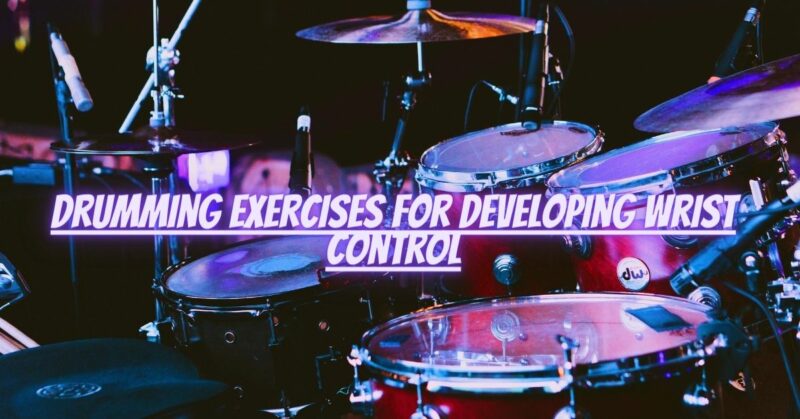Wrist control is a fundamental aspect of drumming technique, enabling drummers to produce dynamic and precise sounds. Developing wrist control enhances your ability to play fast, articulate rhythms, execute smooth transitions, and add finesse to your drumming style. In this article, we will explore a variety of drumming exercises designed to improve wrist control. Incorporating these exercises into your practice routine will help you develop strength, dexterity, and coordination in your wrists, ultimately enhancing your overall drumming skills.
- Wrist Rotation Exercise: Start by holding a drumstick between your thumb and index finger with a loose grip. Begin rotating your wrist in a circular motion while maintaining a consistent tempo. Focus on smooth, controlled movements without any tension in your wrist or hand. Start with small rotations and gradually increase the diameter of the circles. This exercise promotes flexibility and fluidity in wrist motion.
- Single Stroke Roll: The single stroke roll is a foundational exercise that helps develop wrist control and endurance. Start by playing alternating single strokes between your hands on a practice pad or drum. Begin at a slow tempo, focusing on consistent dynamics and precise stick heights. Gradually increase the speed while maintaining control and evenness between your hands. Pay attention to the rebound of the stick, utilizing the natural motion of your wrists for efficient movement.
- Accented Wrist Flicks: This exercise focuses on developing wrist control for accented notes. Start by playing a series of single strokes on a drum or practice pad, with each stroke followed by a quick flick of the wrist to accentuate the next note. Begin slowly, ensuring that the accents are clear and controlled. As you become more comfortable, increase the speed and experiment with different accent patterns, such as accenting every other stroke or creating accents in syncopated patterns.
- Wrist Extension/Flexion Exercise: Place your hand on a flat surface, palm down, and keep your fingers relaxed. Begin by flexing your wrist upward, raising your hand toward your body while maintaining contact with the surface. Then, extend your wrist downward, lowering your hand away from your body. Repeat this motion in a controlled and smooth manner. This exercise strengthens the muscles in your wrist and promotes flexibility.
- Paradiddle Exercise: The paradiddle is a versatile drumming pattern that develops both hand and wrist control. Start by playing the traditional paradiddle (RLRR LRLL) on a practice pad or drum, focusing on maintaining an even tempo and consistent dynamics. Once you are comfortable with the basic pattern, experiment with variations, such as adding accents or orchestrating the pattern around the drum set. The paradiddle exercise enhances coordination and helps you become comfortable with different wrist motions.
- Flam Exercise: Flams are an excellent way to develop control and precision in your wrist movements. Begin by playing alternating flams (soft note followed by a loud note) between your hands on a practice pad or drum. Focus on maintaining a consistent distance between the grace note (soft note) and the primary note (loud note). Start at a slow tempo and gradually increase the speed while ensuring clarity and control in your flam strokes.
- Double Stroke Roll: The double stroke roll is another exercise that improves wrist control and speed. Start by playing two quick strokes with each hand, making sure the second stroke is as controlled and precise as the first. Practice this pattern slowly and gradually increase the speed while maintaining evenness between both hands. Concentrate on using your wrists to execute the double strokes, rather than relying solely on finger control.
Conclusion: Developing wrist control is crucial for drummers seeking to enhance their technique, speed, and overall musicality. By incorporating exercises that promote wrist rotation, single stroke rolls, accented wrist flicks, wrist extension/flexion, paradiddles, flams, and double stroke rolls, you’ll strengthen your wrist muscles, improve coordination, and refine your drumming skills. Remember to practice with a relaxed grip, focus on control and precision, and gradually increase speed as your wrists become stronger and more agile. With consistent practice and dedication, you’ll unlock new levels of expressiveness and versatility in your drumming.

